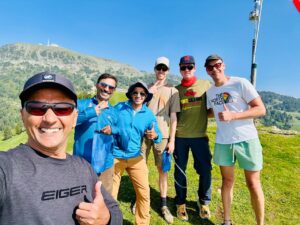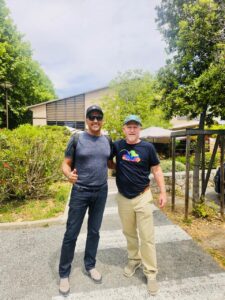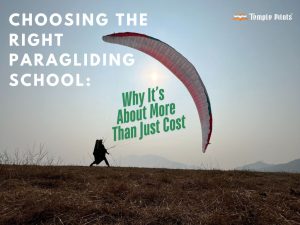Paragliding in Bali, Indonesia : The Learnings by Mihir Joisher
Learning from BaliBliss2022
This was my first time flying at a new site, let alone an international flying site. Along with the locals, there was a group of Australian pilots and a few independent individuals from Austria. They were a treat to watch in every way. The two most important things before flying began, we had to make sure of our preflight preps and our mental state. Flying at a different site, especially an international site, we need to be conscious of every single second that we spend in the takeoff area, the skies, as well as the landing zone. Unlike our home sites in Kamshet, the environment and the energy are totally different there. For example, at Kamshet, there were quite a few times I observed people spreading and connecting gliders at takeoff. This wasn’t the case here. Every single person on the takeoff area was ready with their glider waiting for the pilot in front of them to takeoff. It did add some pressure, being a new club pilot, but a big lesson it taught me was that nobody is above the sport and we aren’t entitled to take our own sweet time to launch.
Total number of flight – 10
Total hours clocked – 13 hours 50 mins
Glider – BGD Epic 2 (65-85kg) S size Site details
– The area that we were flying over was close to Nusa Dua which is on the southern side of Bali facing the majestic Indian Ocean. Timbis and Gunung Payung were the 2 take off sites we flew at. We’d choose our takeoffs depending on the wind conditions for the day. The takeoff at Timbis was more top-landing friendly than the one at Gunung Payung. We flew more from Gunung Payung and had only two flights from Timbis. The contour from the take off at Gunung Payung was such that the ridge was slightly cross to the winds, but on the right side was a curve that was facing the wind. That was the area which had the maximum lift closest to takeoff. Timbis had a similar contour, with the ridge curving on the right side of the takeoff but it also had a carve at the turn which was a potential venturi zone. More about the ridge, it was a 5 km wide ridge with 4 different takeoff points, but because of the winds and the contours of the ridge, the whole ridge couldn’t be traversed in one flight. The winds were generally from the SE or ESE.
Here are a few of my learnings from flying in Bali:
* Understanding aerology in coastal areas: Coastal flying is very different from flying on our home site in Kamshet. The winds are smoother but stronger. Getting a better feel of the winds and estimating where the lift band would be. * Traffic management: Since I’ve only flown in Kamshet, I’ve never really experienced proper traffic in the skies. I flew here in the empty skies, some medium traffic and quite heavy traffic here. This was my first experience in heavy air traffic. About 30 odd gliders sharing the ridge at one particular moment. It was very overwhelming at first. It took me 2 flights to get comfortable in traffic. Once, with the knowledge of lift band, we knew the inner and outer line and followed the circuit so as to not disturb the others. Giving priority to local tandems, following ridge rules, and respecting other gliders’ space by creating separation when needed.
* Altitude management: Depending on the speed of the winds, the lift band kept changing. Maximising my height, going out, losing height, and gaining that height again was my aim for most of the days towards the end. Gauging the lift band (sometimes the outer line had more lift than the inner line). Observation is key. Observing where other gliders are gaining height and not just go on theory was an important learning. Along with the right curve ridge facing the wind which had a good lifty area near the takeoff, once we had height and travelled on a down beat towards our left side limitation there were a few lifty areas there as well. But to reach there we needed height, which we gained close to the takeoff and travelled there.
* Smooth independent takeoffs: 10 flights, 10 reverse launches. All smooth, only a couple of takeoffs initially where my brake lines were twisted because I didn’t hold the risers right for reverse inflation.
* Independent beach landings: The first time landing on the beach was not how I expected landings to be for two main reasons. We always land perpendicular to the wind and make our approach the same way. Here we had to make our final approach with a slight crabbing angle, so we’re sort of facing the sea, which initially played in my head like no matter how good you are with your theory on crabbing, when the land gets closer that flies right out of your head, oh my god I’m heading into the sea. The second reason is that I was accustomed to landing on hard ground. Failing to realise this is soft sand, it was a light bulb moment for me when I landed that I had to be very light on my feet. The first beach landing was guided. The rest of all beach landings were independent. Final approaches were extremely important because of the tides. The beach was sometimes narrower and sometimes broad. One strategy I implemented from the briefing was to secure your landing first and then lose height, so I applied that. With winds being slightly on the stronger side we travelled ahead less and we’re sinking more. * Beach kiting, deflation, and glider care: After getting used to landing on the beach, I began kiting my glider to where I wanted to go and deflating it there so that as little sand as possible got in. Strong wind landings were a key learning point I only tried B line deflation once just to get a feel for it. Rest of the times quick deflation and walking towards the glider worked just fine. Taking proper care of the glider before packing and packing cleanly, efficiently and quickly.
* Good induced pitch and pitch control: I did 8 pitch controls 3 guided others on my own. Improving each time. Key learning was understanding glider drift if it wasn’t done exactly into the wind. This also helped in getting to know the energy of my glider and progress towards other manoeuvres.
* Good induced roll and roll control: My glider was rolling a lot on its own and I wasn’t controlling it well initially. Essentially the glider I use is sensitive to weight shift and I was oscillating in my harness which kept on increasing the roll. After stabilising my glider, I started roll control exercises 4 roll controls. 1 guided 3 by myself. Got the hang of inducing and controlling the roll of a glider * Guided reversals: Thrilling, small taste at Wingovers. I did only 2 guided reversals. First one I did I couldn’t understand the energy of the glider and was shifting my weight early on which could’ve resulted me doing an almost loop unknowingly. Second one was much better much cleaner and the switches were on time. The pitch control exercise helped me understand to check the dive of my glider after exiting.
* Guided top landings: 2 guided top landings, first one was great, second one was iffy. I had some height when I entered the take off area for my approach. I was slightly behind than where I was intended to be. So I applied pressure on my brakes made a few turns left and right. Now my glider started rolling and as it was rolling to the left I saw down and just as I was seeing down I got sudden sink. Now I was fixated on left forgot to get out of the harness completely and applied left brake more than the right and banged on my knee. I need more guided top landing before I even think about trying an independent approach. Key learning was that after a mishap where I hurt my knee, I saw that I could walk so it wasn’t a broken bone or anything just an impact wound, I dressed the wound and took off immediately so as to not drown in the negatives right then and there.
* Understanding big ears and uses: Using big ears when needed for eg to create vertical separation in traffic was key and to lose height to approach for top landings were 2 practical uses.
* Understanding speedbar and uses: Getting to know by applying speedbar and how much to apply was one task I took up just feeling how much extra speed I get. Another practical application was to avoid getting stuck in a Venturi. I could understand the glider moving forward very slowly so I used the speedbar to avoid being stuck there incase the wind increases or worse yet getting dragged back. I did a couple of full beats with my speedbar applied.
* Airmanship: The most important aspect I believe in this sport is airmanship. Not hogging the lifty areas in traffic, respecting every pilot and learning from their mistakes. A key learning was to be helpful to fellow pilots whenever they needed help, not just while flying.There were moments where we could understand the community or the club aspect of things. For eg: Someone had their speedbar links not connected and another fellow pilot noticed. He immediately told him before take off. If someone was not flying correctly, informing the person and making them understand their mistake would not only save their life but everyone who was sharing the sky with him. Waving at passing pilots just to calm our minds is also a very small gesture of airmanship.
* Connecting with my new glider: The best part about my trip was that I inaugurated my new glider there. My first wing couldn’t have had a better start to her flying. For me, this was more special than riding my own bicycle for the first time. Every minute of flying, I felt more and more connected to my glider. Understanding the limitations of my glider made me extremely comfortable and more safe in my glider. Although kiting is an important way to connect to your glider, understanding while flying was a totally different experience. That crisp sound of hers while inflating, deflating, and packing was music to my ears. I can’t wait to fly with her again!
A big thank you to team Templepilots, Captain, Vikas sir, Jets sir, Neenad sir, Avi sir and Anita tai for making
BaliBliss2022 a wonderful success! Next up, SIV in Bilaspur! Hope to share the skies with you soon!





